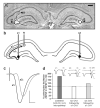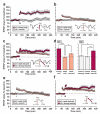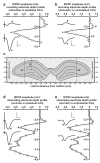Synaptic tagging and capture in the living rat
- PMID: 23212375
- PMCID: PMC3705498
- DOI: 10.1038/ncomms2250
Synaptic tagging and capture in the living rat
Abstract
In isolated hippocampal slices, decaying long-term potentiation can be stabilized and converted to late long-term potentiation lasting many hours, by prior or subsequent strong high-frequency tetanization of an independent input to a common population of neurons-a phenomenon known as 'synaptic tagging and capture'. Here we show that the same phenomenon occurs in the intact rat. Late long-term potentiation can be induced in CA1 during the inhibition of protein synthesis if an independent input is strongly tetanized beforehand. Conversely, declining early long-term potentiation induced by weak tetanization can be converted into lasting late long-term potentiation by subsequent strong tetanization of a separate input. These findings indicate that synaptic tagging and capture is not limited to in vitro preparations; the past and future activity of neurons has a critical role in determining the persistence of synaptic changes in the living animal, thus providing a bridge between cellular studies of protein synthesis-dependent synaptic potentiation and behavioural studies of memory persistence.
Figures







Similar articles
-
Long-term population spike-timing-dependent plasticity promotes synaptic tagging but not cross-tagging in rat hippocampal area CA1.Proc Natl Acad Sci U S A. 2019 Mar 19;116(12):5737-5746. doi: 10.1073/pnas.1817643116. Epub 2019 Feb 28. Proc Natl Acad Sci U S A. 2019. PMID: 30819889 Free PMC article.
-
Synaptic tagging and long-term potentiation.Nature. 1997 Feb 6;385(6616):533-6. doi: 10.1038/385533a0. Nature. 1997. PMID: 9020359
-
The type IV-specific phosphodiesterase inhibitor rolipram and its effect on hippocampal long-term potentiation and synaptic tagging.J Neurosci. 2004 Sep 1;24(35):7740-4. doi: 10.1523/JNEUROSCI.1796-04.2004. J Neurosci. 2004. PMID: 15342741 Free PMC article.
-
Estradiol and the relationship between dendritic spines, NR2B containing NMDA receptors, and the magnitude of long-term potentiation at hippocampal CA3-CA1 synapses.Psychoneuroendocrinology. 2009 Dec;34 Suppl 1:S130-42. doi: 10.1016/j.psyneuen.2009.06.003. Psychoneuroendocrinology. 2009. PMID: 19596521 Free PMC article. Review.
-
Voltage Imaging in the Study of Hippocampal Circuit Function and Plasticity.Adv Exp Med Biol. 2015;859:197-211. doi: 10.1007/978-3-319-17641-3_8. Adv Exp Med Biol. 2015. PMID: 26238054 Review.
Cited by
-
Behavioral Tagging: A Translation of the Synaptic Tagging and Capture Hypothesis.Neural Plast. 2015;2015:650780. doi: 10.1155/2015/650780. Epub 2015 Aug 25. Neural Plast. 2015. PMID: 26380117 Free PMC article. Review.
-
Synapses tagged, memories kept: synaptic tagging and capture hypothesis in brain health and disease.Philos Trans R Soc Lond B Biol Sci. 2024 Jul 29;379(1906):20230237. doi: 10.1098/rstb.2023.0237. Epub 2024 Jun 10. Philos Trans R Soc Lond B Biol Sci. 2024. PMID: 38853570 Free PMC article. Review.
-
Memory allocation at the neuronal and synaptic levels.BMB Rep. 2024 Apr;57(4):176-181. doi: 10.5483/BMBRep.2023-0176. BMB Rep. 2024. PMID: 37964638 Free PMC article. Review.
-
Locus Coeruleus and Dopamine-Dependent Memory Consolidation.Neural Plast. 2017;2017:8602690. doi: 10.1155/2017/8602690. Epub 2017 Oct 16. Neural Plast. 2017. PMID: 29123927 Free PMC article. Review.
-
A Simplified Plasticity Model Based on Synaptic Tagging and Capture Theory: Simplified STC.Front Comput Neurosci. 2022 Feb 11;15:798418. doi: 10.3389/fncom.2021.798418. eCollection 2021. Front Comput Neurosci. 2022. PMID: 35221955 Free PMC article.
References
-
- Martin SJ, Grimwood PD, Morris RGM. Synaptic plasticity and memory: an evaluation of the hypothesis. Annu. Rev. Neurosci. 2000;23:649–711. - PubMed
-
- Wiesel TN, Hubel DH. Single-cell responses in striate cortex of kittens deprived of vision in one eye. J. Neurophysiol. 1963;26:1003–1017. - PubMed
-
- Hubener M, Bonhoeffer T. Searching for engrams. Neuron. 2010;67:363–371. - PubMed
-
- Hawkins RD, Kandel ER, Bailey CH. Molecular mechanisms of memory storage in Aplysia. Biol. Bull. 2006;210:174–191. - PubMed
Publication types
MeSH terms
Substances
Grants and funding
LinkOut - more resources
Full Text Sources
Miscellaneous

